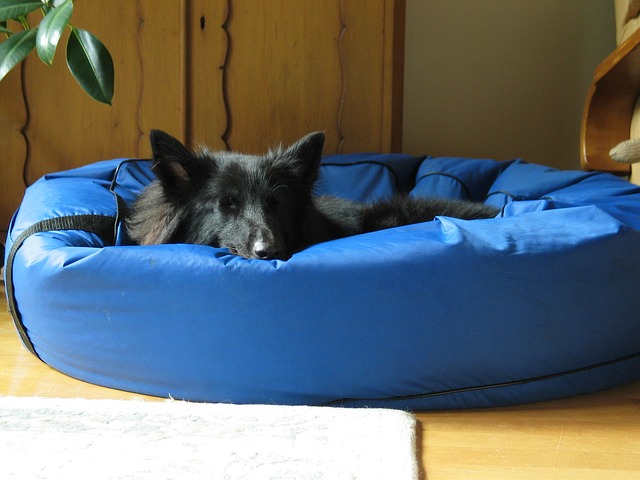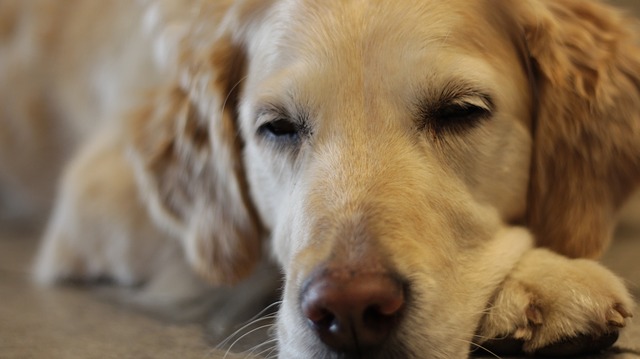As your dog enters his golden years, you’ll notice that his naps become longer and more frequent. The average dog needs 10 hours of sleep a day, but our senior dogs require even more, and it’s very important that he gets all of it.
A lack of sleep can negatively affect a dog’s mood, memory, and concentration. According to Dr. Jennifer Coates at PetMD, “If your dog seems grumpy, forgetful, disoriented, or has difficulty concentrating or performing his usual tasks, sleep deprivation is one possible diagnosis.”
Senior dogs tend to slow down and tire out more easily than they did when they were younger, but they also have more trouble falling asleep. Disruptors like light, noise, and stress can also make it difficult for senior dogs to get enough rest.

One of the best things you can do to ensure your dog is getting his full 10+ hours is to provide him with a safe, quiet space and a suitable bed. There are tons of dog beds on the market, and as you find your friend spending more time in his, you’ll want to make sure that he’s comfortable in it. Here are a few key things to consider when choosing a bed to suit your dog’s needs, and where to place it in your home.
RELATED: The 9 Best Beds For Senior Dogs

Support
One of the most important things to consider when purchasing a bed for your dog is whether the one you choose has adequate support. Although a soft bed may seem comfortable, a senior dog, especially one with joint issues, shouldn’t just sink into it.
A firmer dog bed will provide more support for your dog’s joints and will be easier for him to get in and out of it. Beds made with fillings that can be moved around inside aren’t the best choice, with the filling either being pushed around your dog (rather than under him) or “clumping” with use. It should adapt to all of his positions, not just his favorite position. If it doesn’t spring back, he may wake up every time he wants to move so that he can readjust his bed.
Orthopedic dog beds are designed to support the joints in your dog’s body, particularly his back. Many are made with memory foam, which is soft enough to relax on, but firm enough to keep him from sinking to the floor. Memory foam also resists conforming permanently to your dog’s shape, so it won’t become misshapen by him using it.
An easy test to try while you’re shopping: press your hand into the cushion of the dog bed. If you can feel the floor, or if the filling moves around your hand (like foam beads often do) your dog isn’t likely to be comfortable in it.
Related: 12 Best Dog Beds

Accessibility
Older dogs aren’t likely to hop out of bed in the morning – and it’s probably for the best that he doesn’t. Stiff joints are common in elderly dogs in the morning, so leaping out of bed or even lifting his legs very high can be an actual pain. It may not be something he wants to do at all when he’s tired, and if he’s not as agile as he once was, it could cause him injury, especially on slippery floors.
The solution? Keep it simple. Your senior dog’s bed should be low to the ground, no elevated beds, and without railings, or even “walls”. These will keep him from having to step up, down, or over to get into or out of his bed. If your dog prefers to lean against the walls of his bed, there are beds that allow easy access from one side, but keeps the other walls there for him.

Temperature
Temperature is another common sleep disruptor, and often it’s because your dog gets too warm. Some materials have been known to retain heat, which makes them uncomfortable and difficult to sleep on. A bed made with “thermoneutral” materials – materials that don’t retain much heat – will offer your dog better, uninterrupted sleep.
Although fleece or wool might seem nice and soft, they’re more likely to retain heat, making your dog feel warmer than is comfortable. Fabrics like cotton “breathe” better than thicker, denser fabrics, so they don’t hold on to all of your dog’s body heat. A cool, washable, waterproof cover is a great idea for a dog who might be having bladder issues or “accidents” in his bed.
Worried memory foam might be too warm for your dog, even with a breathable dog bed cover? Gel-infused memory foam offers great support and includes gel that keeps the bed cool.

Location
It’s a good idea to have multiple beds in different locations throughout your house.
Although the laundry room might seem like a nice, out-of-the-way place for a dog bed, remember that those machines are loud, and your dog needs to have a quiet place to rest even on laundry day. If your house has multiple stories, a spot somewhere on the ground floor is ideal, so he doesn’t have to navigate the stairs first thing in the morning, or when he’s tired. If his bed is too hard to access, he may end up not using it at all.
As your dog gets older, it’s likely that he’ll need to go potty more frequently, or the need to go may become more urgent when he wakes up. Placing your dog’s bed near the door can help avoid unwanted accidents, and allow him to zip out when he needs to if you have a dog door.
Look for a quiet spot in a low-traffic area of your home, preferably on the ground floor in a place not too far from the door. The dog bed(s) should never be behind closed doors – your dog ought to be able to access it any time he needs to. Lastly, if you don’t already, consider keeping a dog bed in the room where you sleep (more below).

Sense of Security
Even dogs in the wild don’t sleep out in the open – it’s an instinct that our domesticated dogs still have. Dogs feel safest in quiet, enclosed spaces. This doesn’t mean you need to use a crate, even a nice quiet corner can feel more secure than just any spot.
Should you choose to use a kennel, the door should always be open and it should always be a happy, safe place where your dog is willing to go – never, ever used as punishment.
At their core, our dogs are pack animals, and you are the most important member of his pack. You provide a sense of security for your dog that nothing else can. The place your dog feels safest is by your side – placing his bed in your room, or the room you spend the most time in, can help your dog sleep more soundly and wake feeling happier and better rested.
When it comes to dog beds, there are so many options, so be sure to do your homework and select the bed that best suits your pup’s needs. After all, what could be more important than getting a good night’s rest?
 Toledo, United States.
Toledo, United States.